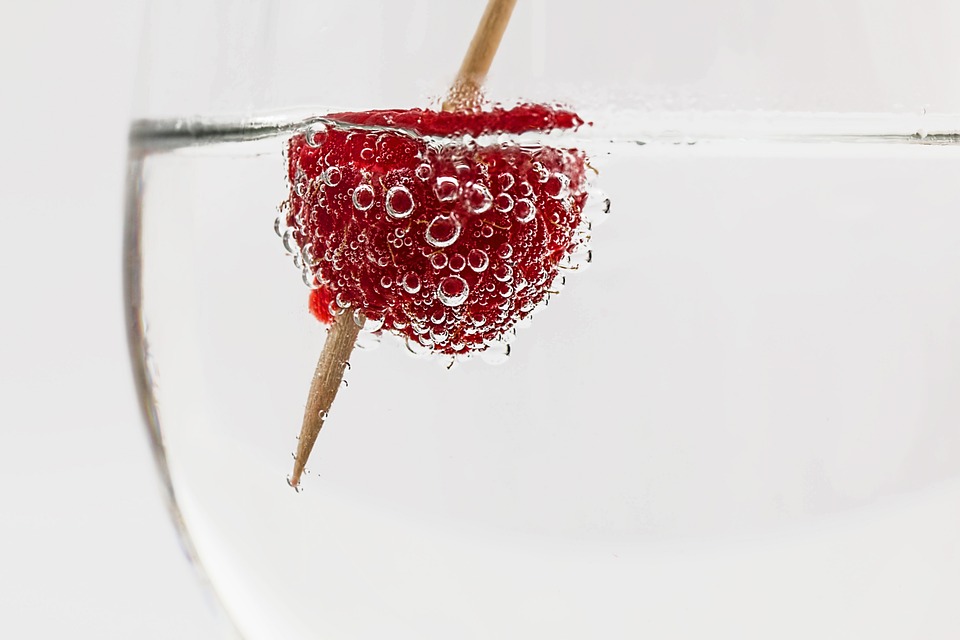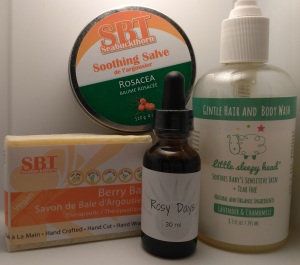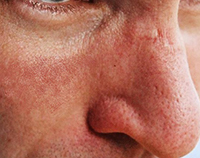Skin Conditions are Expensive and 2020 Needs All the Discounts It Can Get!
I’ve decided to do something new for 2020. Since most of us are doing a chunk of our holiday shopping from home this year, I’ve collected the best rosacea skin care Black Friday sales and deals that I can find to share them with you.
All I’m Promising is a Chance to Save Money
Though these are all rosacea skin care products that I’ve tried and like, as I’ve said a bajillion times before, I can’t guarantee they’ll be right for your skin. We all have our own unique combinations of signs, symptoms, triggers and stuff that works. That said, in case you’ve found that some of the same products work for you as work for me – or if you were hoping to save money as you try them for the first time – here are some of the best ones I’ve tested over the years, and the discounts they’re offering today.
To be clear, I’m not selling any of this stuff. All the links I’m providing are to the stores where I shop for these rosacea skin care products. These are not my stores, but they are holding great Black Friday sales!
My 2020 List of the Best Rosacea Skin Care Black Friday Deals
1. Noble Naturals
The Deal: 25% off nearly the whole site + a free gift worth $50 on orders over $100.
Use Coupon Code BF at checkout to apply your discount.
I can’t say enough good things about this skin care company and its products. I’ve been using the same Noble Naturals rosacea skin care products for almost a full year, and they’ve given me the same beautiful performance through the winter, spring, summer, fall, and now returning to winter again. Extremely gentle and hydrating products. I raved about them in a recent review on my rosacea blog.
The Best Rosacea Skin Care Products for My Face
- Noble Naturals Calming Chamomile Cleansing Cream (used morning/night)
- Noble Naturals Calming Chamomile & Witch Hazel Toning Mist (used morning)
- Noble Naturals Calming Chamomile Floral Mist (used night)
- Noble Naturals Isla Anti-Inflammatory Facial Oil (used morning/night)
Other Favorites from Noble Naturals
- Noble Naturals Calm Balm (for freezing, windy days when skin needs more protection)
- Noble Naturals Breathe Easy Balm (use it under the nose to stop it from running outside in the cold..and under masks!)
- Noble Naturals Goddess Bath Bomb with Gemstone Centre (most gorgeous-smelling bath balm I’ve ever used. Skin feels pampered after this bath. Just don’t forget the gemstone is in there and step on it as you’re getting out…no reason…)
- Noble Naturals Dream Weaver Ritual Mist (a gentle, calming scent for bedtime that, surprise, isn’t lavender. For me, it’s soothing, opens airways and helps me to be restful and ready to dream)
- Noble Naturals Gemstone Jewelry (perfect gifts for yourself or anyone on your shopping list. It’s all just as beautiful as it looks in the photos…not that I’ve been buying it for myself…)
2. Bedrock
The Deal: 20% off your whole order of anything on the site
I originally fell in love with Bedrock as a brand when I tried the Bedrock Balm, which worked wonders on helping to heal a nasty flare-up (which I documented on my Rosy JulieBC blog).
I’ve started using it on mosquito bites, scrapes, and even the occasional regular pimple that decides to make a rare appearance.
Since then, I’ve had the chance to try other products from the same brand and they’re all just as great. They’re simple, gentle, and lovely. This is a great chance to try them out or stock up!
THE BEST ROSACEA SKIN CARE PRODUCTS FOR MY FACE’s Flare-Up Recovery
- Bedrock Balm (used day/night in summer and at night in winter)
Other Favourites from Bedrock
- Bedrock FRESHSTICK (soft-smelling mineral and matcha deodorant in a cardboard container. No plastic! It stands up to some pretty stressful and sweaty days for me in 2020)
3. RubyLux Lights*
The Deal: 30% off any order of $50 or more.
I’ve been using light therapy for five years and have come to trust two brands. While one of those two brands has shifted gears and has focused on education about light therapy for rosacea and other conditions, the other, RubyLux Lights, has continued to grow and fine-tune its offerings.
There have been a lot of companies rushing into this industry, some of whom have been more trustworthy than others. Every RubyLux product I’ve tried so far has been consistently good quality, and I’ve always had my questions answered quickly and respectfully on the few occasions I’ve contacted them.
*(affiliate link)
My Favourite RubyLux Lights Products for Rosacea Light Therapy
- RubyLux Highest Intensity LED Light Therapy Mask with Neck Piece (originally used daily, but now used every one to two weeks)
- RubyLux All Red LED Bulb – Small – 2nd Generation (super-affordable way to try red light therapy for the first time)
- RubyLux Amber Yellow LED Bulb – Size Small – 2nd Generation (super-affordable way to try yellow light therapy for the first time)
- RubyLux Basic Goggles (simple way to protect your eyes from the very bright light)
Other Favourites from RubyLux Lights
- RubyLux All Red LED Bulb – Size Large – 2nd Generation (larger option lets you do your whole face in one or two sides, saving time)
- RubyLux All Yellow LED Bulb – Size Large – 2nd Generation (again, lets you do your whole face much faster than the small bulb)
- RubyLux All Green LED Bulb – Size Large (after all these years, I’ve been off-and-on about whether green light therapy calms my redness, but it is extremely soothing to a flare-up for me)
Still Hunting for the Best Rosacea Skin Care Black Friday Deals
These are the best rosacea skin care Black Friday deals I could find so far. If I spot some more throughout the day, I’ll be sure to add them! Take care and stay safe, Rosy Friends.








 As you learn about the lifestyle changes that you can make to easily keep your symptoms under control, don’t forget that rosacea home remedies can be some of the simplest and most affordable weapons in your arsenal for combating redness, bumps, dryness, itchiness, burning, and other discomforts.
As you learn about the lifestyle changes that you can make to easily keep your symptoms under control, don’t forget that rosacea home remedies can be some of the simplest and most affordable weapons in your arsenal for combating redness, bumps, dryness, itchiness, burning, and other discomforts.

 As effective as
As effective as  There are a number of different kinds of diet that have been attempted and that many rosacea sufferers swear by.
There are a number of different kinds of diet that have been attempted and that many rosacea sufferers swear by. This method takes longer than an elimination diet, but it means that you don’t necessarily have to make any major changes to the foods that you eat unless they are shown to be triggers for your symptoms.
This method takes longer than an elimination diet, but it means that you don’t necessarily have to make any major changes to the foods that you eat unless they are shown to be triggers for your symptoms. Therefore, many people feel that a diet to reduce or kill H. pylori can help to minimize the symptoms of rosacea as well. This type of diet helps to reduce or heal an infection of that type of bacteria in the stomach lining.
Therefore, many people feel that a diet to reduce or kill H. pylori can help to minimize the symptoms of rosacea as well. This type of diet helps to reduce or heal an infection of that type of bacteria in the stomach lining. Another potential cause of rosacea symptoms is believed to be certain chronic inflammatory conditions. This includes a broad range of different health concerns that range from heart disease to Alzheimer’s disease and a long list in between. Inflammation is essentially swelling in the body. When the body swells, it produces local heat, redness, swelling and even stinging and/or pain in the affected area.
Another potential cause of rosacea symptoms is believed to be certain chronic inflammatory conditions. This includes a broad range of different health concerns that range from heart disease to Alzheimer’s disease and a long list in between. Inflammation is essentially swelling in the body. When the body swells, it produces local heat, redness, swelling and even stinging and/or pain in the affected area. Some studies have linked the existence of rosacea symptoms with a bacteria or Candida albicans overgrowth in the small intestine. This has led many people to choose a probiotic rosacea diet to help to boost the “good” flora while pushing out the “bad” flora in the digestive tract.
Some studies have linked the existence of rosacea symptoms with a bacteria or Candida albicans overgrowth in the small intestine. This has led many people to choose a probiotic rosacea diet to help to boost the “good” flora while pushing out the “bad” flora in the digestive tract. Some research has indicated that people who have certain autoimmune disorders have an increased risk of rosacea. Therefore, if you have rosacea and certain other risk factors for an autoimmune disorder, it may be worth your while to be tested. Among the most common autoimmune disorders linked with rosacea symptoms are Type 1 diabetes and celiac disease.
Some research has indicated that people who have certain autoimmune disorders have an increased risk of rosacea. Therefore, if you have rosacea and certain other risk factors for an autoimmune disorder, it may be worth your while to be tested. Among the most common autoimmune disorders linked with rosacea symptoms are Type 1 diabetes and celiac disease.

 When the weather is extreme, try to stay in as much as possible. Very low temperatures and biting winds will only make things worse, fast. If you must head out, use a ski mask or scarf to keep your face protected.
When the weather is extreme, try to stay in as much as possible. Very low temperatures and biting winds will only make things worse, fast. If you must head out, use a ski mask or scarf to keep your face protected. Sit back from the fireplace. Try not to sit too close to any specific heat source as it will only warm and dry your skin, increasing the risk of a flare-up or at least a deeper blush.
Sit back from the fireplace. Try not to sit too close to any specific heat source as it will only warm and dry your skin, increasing the risk of a flare-up or at least a deeper blush. Gentle cleansing. Use an extremely gentle rosacea skin care product for cleansing. The goal isn’t to have a “squeaky clean” feeling once you’re done. Instead, the idea is to remove the dirt, unwanted bacteria, product and excess oils while leaving some skin oils in place. Healthy skin does have some oil left on it. You want your skin to be clean, not stripped. In most situations, twice-daily cleansing is all you need.
Gentle cleansing. Use an extremely gentle rosacea skin care product for cleansing. The goal isn’t to have a “squeaky clean” feeling once you’re done. Instead, the idea is to remove the dirt, unwanted bacteria, product and excess oils while leaving some skin oils in place. Healthy skin does have some oil left on it. You want your skin to be clean, not stripped. In most situations, twice-daily cleansing is all you need. When you continually have a red face that looks as though you have a sunburn that won’t go away, you will likely start to wonder what’s going on with your complexion. This becomes more confusing when those rosy cheeks are accompanied by additional symptoms such as itching, burning, extreme dryness, or little pimples that resemble whiteheads.
When you continually have a red face that looks as though you have a sunburn that won’t go away, you will likely start to wonder what’s going on with your complexion. This becomes more confusing when those rosy cheeks are accompanied by additional symptoms such as itching, burning, extreme dryness, or little pimples that resemble whiteheads.
 Since the cause of rosacea has yet to be identified, no cure is known, either. No matter what any product sales page or person may tell you, a cure for rosacea does not yet exist.
Since the cause of rosacea has yet to be identified, no cure is known, either. No matter what any product sales page or person may tell you, a cure for rosacea does not yet exist.![What is Rosacea? Rosacea Symptoms, Triggers & Causes [With Pictures] - Rosy JulieBC What is Rosacea? Rosacea Symptoms, Triggers & Causes [With Pictures] - Rosy JulieBC](https://rosyjuliebc.files.wordpress.com/2017/10/what-is-rosacea.jpg)




 Although the term “acne rosacea” is used as though it is a form of this condition, it is actually a kind of misnomer for subtype 2.
Although the term “acne rosacea” is used as though it is a form of this condition, it is actually a kind of misnomer for subtype 2.